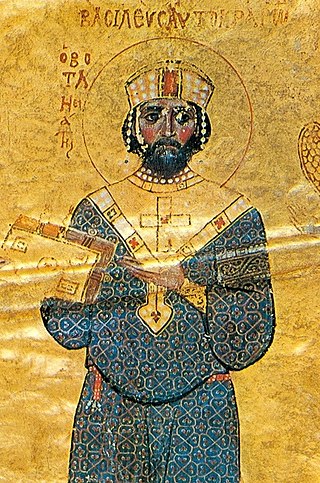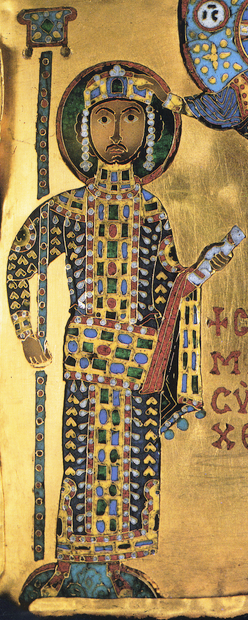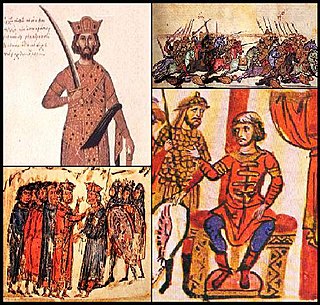Related Research Articles

Alexios I Komnenos, Latinized Alexius I Comnenus, was Byzantine emperor from 1081 to 1118. Although he was not the first emperor of the Komnenian dynasty, it was during his reign that the Komnenos family came to full power and initiated a hereditary succession to the throne. Inheriting a collapsing empire and faced with constant warfare during his reign against both the Seljuq Turks in Asia Minor and the Normans in the western Balkans, Alexios was able to curb the Byzantine decline and begin the military, financial, and territorial recovery known as the Komnenian restoration. His appeals to Western Europe for help against the Turks was the catalyst that sparked the First Crusade.

Isaac I Komnenos or Comnenus was Byzantine emperor from 1057 to 1059, the first reigning member of the Komnenian dynasty.

Nikephoros III Botaneiates, Anglicised as Nicephorus III Botaniates, was Byzantine Emperor from 7 January 1078 to 1 April 1081. He was born in 1002, and became a general during the reign of Byzantine Emperor Constantine IX Monomachos, serving in the Pecheneg revolt of 1048–1053. His actions in guiding his forces away from the Pechenegs following the Battle of Zygos Pass, in which they suffered eleven days of harassment before finally reaching the Byzantine city of Adrianople, attracted the attention of fellow officers, and he received the title of magistros as a reward. Nikephoros served in the revolt of Isaac I Komnenos against the Byzantine Emperor Michael VI Bringas, leading forces at the decisive Battle of Petroe. Under the Emperor Constantine X Doukas he was made doux of Thessalonica, where he remained until c. 1065, when he was reassigned as doux of Antioch. While doux of Antioch, he repelled numerous incursions from the Emirate of Aleppo. When Constantine X died in 1067, his wife, Empress Eudokia Makrembolitissa, considered taking Nikephoros as husband and emperor but instead chose Romanos IV Diogenes. The need for an immediate successor was made pressing by the constant Seljuk raids into Byzantine Anatolia, and Eudokia, Patriarch John VIII of Constantinople, and the Byzantine Senate agreed that their top priority was the defense of the empire and that they needed an emperor to lead troops to repel the Turks. Nikephoros was the favorite candidate of the senate, but was in the field leading troops in Antioch and was still married. Romanos, once chosen to be emperor, exiled Nikephoros to his holdings in the Anatolic Theme, where he remained until he was brought out of retirement by the Emperor Michael VII and made kouropalates and governor of the Anatolic Theme.

Michael VII Doukas or Ducas, nicknamed Parapinakes, was the senior Byzantine emperor from 1071 to 1078. He was known as incompetent as an emperor and reliant on court officials, especially of his finance minister Nikephoritzes, who increased taxation and luxury spending while not properly financing their army. Under his reign, Bari was lost and his empire faced open revolt in the Balkans. Along with the advancing Seljuk Turks in the eastern front, Michael also had to contend with his mercenaries openly turning against the empire. Michael stepped down as emperor in 1078 and later retired to a monastery.

The Battle of Kalavrye was fought in 1078 between the Byzantine imperial forces of general Alexios Komnenos and the rebellious governor of Dyrrhachium, Nikephoros Bryennios the Elder. Bryennios had rebelled against Michael VII Doukas and had won over the allegiance of the Byzantine army's regular regiments in the Balkans. Even after Doukas's overthrow by Nikephoros III Botaneiates, Bryennios continued his revolt, and threatened Constantinople. After failed negotiations, Botaneiates sent the young general Alexios Komnenos with whatever forces he could gather to confront him.

The Byzantine–Bulgarian wars were a series of conflicts fought between the Byzantine Empire and Bulgaria which began after the Bulgars conquered parts of the Balkan peninsula after 680 AD. The Byzantine and First Bulgarian Empire continued to clash over the next century with variable success, until the Bulgarians, led by Krum, inflicted a series of crushing defeats on the Byzantines. After Krum died in 814, his son Omurtag negotiated a thirty-year peace treaty. Simeon I had multiple successful campaigns against the Byzantines during his rule from 893 to 927. His son Peter I negotiated another long-lasting peace treaty. His rule was followed by a period of decline of the Bulgarian state.
Leo Phokas was an early 10th-century Byzantine general of the noble Phokas clan. As Domestic of the Schools, the Byzantine army's commander-in-chief, he led a large-scale campaign against the Bulgarians in 917, but was heavily defeated at the battles of Acheloos and Katasyrtai. He then plotted to seize the throne from the young Byzantine emperor Constantine VII, but was outmaneuvered by the admiral Romanos Lekapenos, who managed to become guardian and later father-in-law of the Emperor. After Lekapenos seized control of the Byzantine Empire, Leo led an unsuccessful revolt, and was captured and blinded.
Nikephoros Bryennios the Elder, Latinized as Nicephorus Bryennius, was a Byzantine Greek general who tried to establish himself as Emperor in the late eleventh century. His contemporaries considered him the best tactician in the empire.

Nikephoros Basilakes, frequently encountered simply as Basilakios (Βασιλάκιος), Latinized as Nicephorus Basilacius, was a Byzantine general and aristocrat of the late 11th century, who in 1078 tried to overthrow the Emperor Nikephoros III Botaneiates and was defeated by Alexios Komnenos. Nikephoros is described as the most illustrious member of his family. His father was named Phloros, and his brother was Manuel Basilakes.
Nikephoros Melissenos, Latinized as Nicephorus Melissenus, was a Byzantine general and aristocrat. Of distinguished lineage, he served as a governor and general in the Balkans and Asia Minor in the 1060s. In the turbulent period after the Battle of Manzikert in 1071, when several generals tried to seize the throne for themselves, Melissenos remained loyal to Michael VII Doukas and was exiled by his successor Nikephoros III Botaneiates. In 1080–1081, with Turkish aid, he seized control of what remained of Byzantine Asia Minor and proclaimed himself emperor against Botaneiates. After the revolt of his brother-in-law Alexios I Komnenos, however, which succeeded in taking Constantinople, he submitted to him, accepting the rank of Caesar and the governance of Thessalonica. He remained loyal to Alexios thereafter, participating in most Byzantine campaigns of the period 1081–1095 in the Balkans at the emperor's side. He died on 17 November 1104.
Basil Apokapes was a Byzantine general of the 11th century.
Constantine Diogenes was a prominent Byzantine general of the early 11th century, active in the Balkans. He served with distinction in the final stages of the Byzantine conquest of Bulgaria under Emperor Basil II, and occupied high commands in the Balkans until his arrest in 1029, as the result of his participation in a conspiracy against Emperor Romanos III Argyros. Imprisoned and forced to enter a monastery, he killed himself in 1032 during an inquest on a further conspiracy. He was the father of Emperor Romanos IV Diogenes.

Sviatoslav's invasion of Bulgaria refers to a conflict beginning in 967/968 and ending in 971, carried out in the eastern Balkans, and involving the Kievan Rus', Bulgaria, and the Byzantine Empire. The Byzantines encouraged the Rus' ruler Sviatoslav to attack Bulgaria, leading to the defeat of the Bulgarian forces and the occupation of the northern and north-eastern part of the country by the Rus' for the following two years. The allies then turned against each other, and the ensuing military confrontation ended with a Byzantine victory. The Rus' withdrew and eastern Bulgaria was incorporated into the Byzantine Empire.
Nikephoros Bryennios, Latinized as Nicephorus Bryennius, was an important Byzantine general who was involved in rebellions against the empress Theodora and later the emperor Michael VI Stratiotikos.
Phokas or Phocas (Latinized), feminine form Phokaina or Phocaena, was the name of a Byzantine aristocratic clan from Cappadocia, which in the 9th and 10th centuries provided a series of high-ranking generals and an emperor, Nikephoros II Phokas. Its members and their clients monopolized the high-command positions of the Byzantine army for much of the 10th century and led the successful Byzantine offensive against the Arabs in the East. As one of the leading families of the Anatolian military aristocracy, the Phokades were also involved in a series of rebellions that laid claim to power and challenged the emperors at Constantinople. Their power was eventually broken by Basil II, and the family declined in importance after the 11th century.
Constantine Arianites was a Byzantine general active in the Balkans against the Pechenegs.
The Pecheneg revolt was an uprising of the Pechenegs against the Byzantine Empire, which lasted from 1049 to 1053. Although the conflict ended with a negotiation of favorable terms with the rebels, it also demonstrated the deterioration of the Byzantine army. Its inability to defeat the rebels foreshadowed the future losses against the Seljuk Turks in the east and the Normans in the west.
Katakalon Tarchaneiotes, mentioned in the works of Nikephoros Bryennios the Younger as Katakalon Katakalos, was an 11th-century Byzantine official, active during the reigns of Michael VII Doukas, Nikephoros III Botaneiates and Alexios I Komnenos.